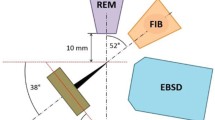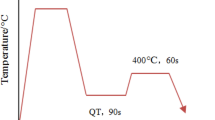Abstract
By thermal neutron irradiation particle tracking autoradiography (PTA) technique, the development of boron segregation at grain boundaries in ultra-low carbon micro-alloy steels was investigated during cooling from 1150°C to 850°C, and the effect of Cu on boron segregation at grain boundaries was discussed. By positron annihilation lifetime(PAL) technique, the changes of vacancy-type defects with temperatures and the effect of Cu on vacancy-type defects in the cooling process were discussed. Results show that, the concentration of boron at grain boundaries increases rapidly at the beginning of the cooling; after that, it begins to decrease; and then, it increases gradually again. The addition of Cu not only increases the concentration of boron at grain boundaries but also speeds up the development process of boron segregation at grain boundaries. During the continuous cooling process, the addition of Cu significantly affects the change of vacancy-type defects with temperatures in ultra-low carbon micro-alloy steels.
Similar content being viewed by others
References
Hwang B, Lee C G, Lee T. Correlation of microstructure and mechanical properties of thermomechanically processed low-carbon steels containing boron and copper. Metall Mater Trans A, 2010, 41: 85–96
Zhang Z W, Liu C T, Guo S, et al. Boron effects on the ductility of a nano-cluster-strengthened ferritic steel. Mater Sci Eng A, 2011, 528: 855–859
Karlsson L, Norden H, Odelius H. Non-equilibrium grain boundary segregation of boron in austenitic stainless steel-I. Large scale segregation behavior. Acta Metall, 1988, 36: 1–12
He X L, Che Y Y, Jonas J J. Grain boundary segregation of boron during continuous cooling. Acta Metall, 1989, 37: 147–161
Jahazi M, Jonas J J. The non-equilibrium segregation of boron on original and moving austenite grain boundaries. Mater Sci Eng A, 2002, 335: 49–61
Faulkner R G. Non-equilibrium grain-boundary segregation in austenitic alloys. J Mater Sci, 1981, 16: 373–383
Xu T D, Chen B Y. Kinetics of non-equilibrium grain-boundary segregation. Prog Mater Sci, 2004, 49: 109–208
Kulikov D, Malerba L, Hou M. On the binding energies and configurations of vacancy and copper-vacancy clusters in bcc Fe-Cu: A computational study. Philosoph Mag, 2006, 86: 141–172
Arokiam A, Barashev A, Bacon D J, et al. Simulation of copper atom diffusion via the vacancy mechanism in a dilute Fe-Cu alloy. Phys Rev B, 2005, 71: 174205
Takahashi A, Soneda N, Ishino S, et al. Structures and energies of vacancy-Cu clusters in α-Fe. Phys Rev B, 2003, 67: 024104
He X L, Chu Y Y. The application of 10B(n, α) 7Li fission reaction to study boron behaviour in materials. J Phys D-Appl Phys, 1983, 16: 1145–1158
Wu P, Yu D Y, He X L. Image manipulation and measurement of boron autoradiograph pictures. Phys Exper, 2005, 25: 21–24
Liu Z C, Guo F L, Wang H Y, et al. High-resolution electron microscopy analysis of Cu-rich clusters. Heat Treat, 2008, 23: 20–24
Sato A, Ishikawa N, Mori T. Nucleation and growth of defect clusters in an electron-irradiate Cu-Fe alloy. Mater Sci Eng, 1986, 81: 427–432
Dutta B, Valdes E, Sellars C M. Mechanism and kinetics of strain induced precipitation of Nb(C,N) in austenite. Acta Metall Master, 1992, 40: 653–662
Wang X G, Zhang H. A study on characteristics of the vacancy complex in Fe-V-N dilute alloy (I). Acta Phys Sin, 1992, 41: 1452–1457
Mohamed H F M, Kwon J, Kim Y M, et al. Vacancy-type defects in cold-worked iron studied using positron annihilation techniques. Nucl Instru Meth Phys Res Sect B: Beam Interact Mater Atoms, 2007, 258: 429–434
Vehanen A, Hautojärvi P, Johansson J, et al. Vacancies and carbon impurities in α-iron: Electron irradiation. Phys Rev B, 1982, 25: 762
Fischer F D, Svoboda J, Appel F, et al. Modeling of excess vacancy annihilation at different types of sinks. Acta Mater, 2011, 59: 3463–3472
Author information
Authors and Affiliations
Corresponding author
Rights and permissions
About this article
Cite this article
Yang, R., Wu, P., Li, X. et al. Effect of Cu on the boron segregation at grain boundaries and vacancy-type defects in ultra-low carbon micro-alloy steels. Sci. China Technol. Sci. 57, 1135–1141 (2014). https://doi.org/10.1007/s11431-014-5552-y
Received:
Accepted:
Published:
Issue Date:
DOI: https://doi.org/10.1007/s11431-014-5552-y




